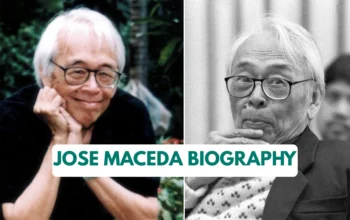Levi Celerio remains one of the most iconic figures in 20th-century Philippine music. A prolific composer and lyricist, he is widely known for penning hundreds—if not thousands—of beloved Filipino songs, for co-writing the lyrics of Sa Ugoy ng Duyan, and for his unusual (and internationally famous) talent of making music with a single leaf. His life spans a dramatic arc from modest beginnings in Tondo, Manila, to being named a National Artist of the Philippines.
Bio Data
- Full Name: Levi Celerio
- Born: April 30, 1910
- Death: April 2, 2002
- Birthplace: Tondo, Manila, Philippine Islands
- Nationality: Filipino
- Occupation: Composer and lyricist; poet; film actor.
- Parents: Cornelio Cruz (father) and Juliana Celerio (mother)
- Spouse: Lina Celerio (also referenced as Leonila José-Celerio in some sources)
- Children: He had children (sources vary — some say 4 children; some mention 12 children from multiple relationships)
Early life and musical beginnings
Levi Celerio was born in Tondo, Manila, on April 30, 1910. Growing up in a poor family, he was fortunate to receive musical training that led him to the Academy of Music in Manila and later made him the youngest member of the Manila Symphony Orchestra. His early exposure to orchestral music and Filipino folk traditions planted the seeds for a lifetime of songwriting that would blend classical sensibilities with popular, folk, and religious themes.
The turning point: from orchestra to songcraft
An injury during his youth (reported as a broken wrist after a fall) cut short his orchestral career and nudged him toward writing, arranging, and composing. Celerio began to focus on songs—lyrics and melodies that resonated with ordinary Filipinos. His output was astonishing in scale: he is credited with writing more than 4,000 songs across genres—folk, love songs, Christmas carols, and film music. That sheer volume made him a household name and a go-to lyricist for composers and filmmakers.
Signature works and collaborations
Celerio’s handwriting is all over Filipino popular music. Some of the songs most commonly associated with him include Ang Pasko ay Sumapit, Pasko Na Naman, Kahit Konting Pagtingin, Ang Pipit, and Itik-Itik. Perhaps his most enduring collaboration was with composer Lucio San Pedro: Celerio wrote the lyrics for Sa Ugoy ng Duyan, a lullaby that has become part of the Philippine national songbook. These works connect with listeners because they blend simple, memorable melodies with lyrics that speak to daily life, love, childhood, and faith.
The leaf player — a singular talent
One of the most unusual facts about Celerio is that he could play music using a leaf. So distinctive was this talent that it earned him notice in record books and international appearances. He performed his leaf-playing on television programs abroad and was often introduced as the world’s leaf player — a tiny, humble instrument producing haunting, human-like tones when handled by an expert. This gimmick was never mere novelty; Celerio treated the leaf as a legitimate voice within his larger musical identity.
Film, poetry, and stage
Besides songwriting, Celerio occasionally appeared in films in the 1950s and 1960s and published poetry and short pieces. His lyrics and film credits expanded his reach: composers and directors tapped his capacity to craft lines that fit popular melodies and cinematic moods. Although his poems drew mixed critical reactions, his songs continued to find a beloved place in Filipino family life, radio, and film.
Honors and national recognition
In 1997 Levi Celerio was honored as a National Artist of the Philippines for Music (and in some sources listed alongside Literature due to his lyrical contributions). The National Artist title is the country’s highest recognition for a Filipino artist whose work greatly enriched the nation’s cultural life. This official recognition cemented his place in the national narrative as both a creative workhorse and a cultural treasure.
Later years and death
Celerio continued to appear in public events in his later years, occasionally performing or attending concerts honoring Filipino musical traditions. He died on April 2, 2002, in Quezon City; reports indicate he suffered from emphysema prior to his death. He was buried with honors, and the Philippine musical community continued to commemorate his songs and idiosyncratic artistry.
Why Levi Celerio matters today
- Prolific output: Writing over 4,000 songs is an extraordinary cultural contribution; those songs form part of the soundtrack of Filipino life across generations.
- Cultural bridges: He translated, adapted, and re-lyricized songs across languages (for example, bringing Visayan carols into Tagalog form), which helped unify diverse Filipino musical traditions.
- A unique performer: The leaf-playing act added an unforgettable trademark and showed that musicality can be inventive and joyful.
- Legacy in education and media: Teachers, choirs, and family gatherings still perform his songs, which keeps his voice alive in everyday cultural practice.
Frequently Asked Questions (FAQs)
When and where was Levi Celerio born?
Levi Celerio was born on April 30, 1910, in Tondo, Manila, Philippines.
How many songs did Levi Celerio write?
He is credited with more than 4,000 songs spanning folk, Christmas carols, love songs, and film music.
Did Levi Celerio receive the National Artist award?
Yes. He was named a National Artist of the Philippines in 1997 for his contributions to music and literature.
Is it true he could play music with a leaf?
Yes. Celerio was famous for his leaf-playing skill, which drew international attention and special mentions in record books.
What are some of his best-known songs?
Notable titles include Ang Pasko ay Sumapit, Pasko Na Naman, Kahit Konting Pagtingin, Ang Pipit, and the lyrics to Sa Ugoy ng Duyan (with Lucio San Pedro).
Conclusion
Levi Celerio’s story is the story of a musician who turned modest beginnings into a lifetime of cultural gifts. His enormous catalog of songs enriched Filipino family traditions, cinema, and popular culture—while his leaf-playing and personal flair made him a figure people remember with a smile. Whether you hear a Christmas carol in December or a lullaby at bedtime, traces of Celerio’s pen and imagination are never far away. His legacy is both a lesson in creative perseverance and an invitation to keep local music alive for future generations.




